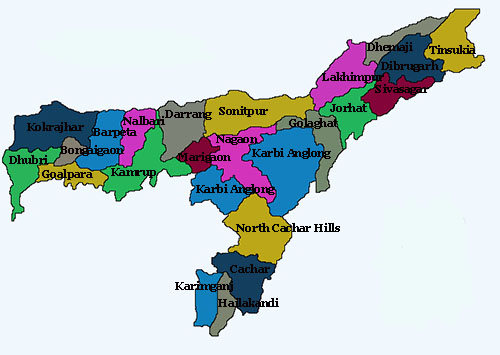– Nirendra Dev
 The Hindu-Muslim relationship and the much talked about religious minorities are the flavour of the season. To top it all has been the release of Population by Religious Communities of Census 2011. Keeping in mind the crucial Bihar elections, the timing of the release of data that was with the government since the time of UPA dispensation is curious. In the context of Assam, the release is likely to lead to a renewed controversy in a state that has witnessed political upheavals and violence in the name of demographic growth and imbalances.
The Hindu-Muslim relationship and the much talked about religious minorities are the flavour of the season. To top it all has been the release of Population by Religious Communities of Census 2011. Keeping in mind the crucial Bihar elections, the timing of the release of data that was with the government since the time of UPA dispensation is curious. In the context of Assam, the release is likely to lead to a renewed controversy in a state that has witnessed political upheavals and violence in the name of demographic growth and imbalances.
Assam’s Muslim population has increased to 34.22 per cent, a quantum leap of over four per cent, while the Hindu population has been around 61.46 per cent. Statistics often conceal more than what they reveal. But for people of Assam, these census figures will be like hot potato politically as elections are due early next year. The regional Asom Gana Parishad and the BJP would be plunging in as at least three new prominent districts in the state now shown a sharp rise in the Muslim population.
In 2001, six districts in Assam were Muslim dominated, but in 2011 it increased to nine. The Muslim majority districts include Barpeta, Dhubri, Karimganj, Goalpara, Darrang, Bongaigaon, Hailakandi, Nagaon and Morigaon.
In Assam, this demographic transition in some pockets — closer to the international border with Bangladesh and some even away from the border — would certainly yet again spark off the debate over the Bangladeshi influx. Nevertheless, it should be kept in mind that in the 1970s during the peak of the students’ agitation, the initial “anti-foreigner” agitation against the influx of Bangladeshis got embroiled in the “Bongali kheda”’ (chase out Bengali) campaign. Even Hindu Bengalis were at times at the receiving end of the local anguish.
Even in 2012, Assam witnessed a bloodbath owing to conflicts of interest between Bodo tribals and Bengali Muslims. The clashes and subsequent remarks from politicians — especially the likes of Hyderabad-based Asaduddin Owaisi, who lately expanded his base in Maharashtra too — aroused passions and undoubtedly created the upsurge for a violent protest in Mumbai. The Mumbai hara-kiri and lopsided handling of the entire situation primarily due to police complicity and the then Congress-NCP regime in Maharashtra actually accentuated the unprecedented exodus of North-east people from hubs like Mumbai, Pune and Bangalore.
Those who propose to rake up “Muslim population increase” in Assam now in the run-up to the 2016 assembly elections should also remember that the genesis of the insane rage in Bodotribal pockets in 2012 also owed its origin to population arithmetic. There has been an interesting and perhaps funny angle to some of the statistical figures those were reported then. It was said only in 2011, in Kokrajhar and neighbouring districts, that the Muslim population was counted at about 235,000, but by June-July 2012 Badruddin Ajmal, chief of the pro-Muslim All India United Democratic Front championing the cause of minorities, said about 500,000 Muslims were in relief camps. So the obvious question was: from where did so many Muslims come so fast?
Even then, Union home minister P Chidambaram admitted that illegal immigration had been one major issue that got lost in the din. That’s the paradox of North-east India. Forwarding the clock to 2015, let us revisit the official data now released by the Census authorities. The Muslim population has increased by 28.8 percentage points in Darrang district, 14.88 points in Kamrup, 13.86 points in Nalbari and 11.37 points in Barpeta. Interestingly, in districts bordering Bangladesh, Dhubri saw a rise of 5.67 points and Karimganj 4.08 points. So does this imply — as Muslims are growing in numbers in districts away from the international border — that there’s a decline in the Bangladeshi influx?
This could be a fallacy as studies reveal Bengali Muslims, and that should include substantial Bangladeshis, have increased in states like Kerala, too. This school of thought maintains that Muslims who do continue to come from Bangladesh “move” on to other states — even outside the North- east region — for employment.
However, what should be a matter of concern is that the political class, including the BJP, in its ambition to wrest power in Assam can lead society into radicalisation. Unfortunately, radicalisation is always a double-edged sword and the North-east often has fallen vulnerable to the same.
As a result, now polarisation is happening among both Hindus and Muslims for various reasons, the main issue obviously related to aspirations and modernisation. Hindu polarisation will add to further woes in Assam. But along with the need to take up welfare programmes in governance-starved states like Assam, the authorities would do well to note that the Jihadist movements, should not enter Indian homes.
